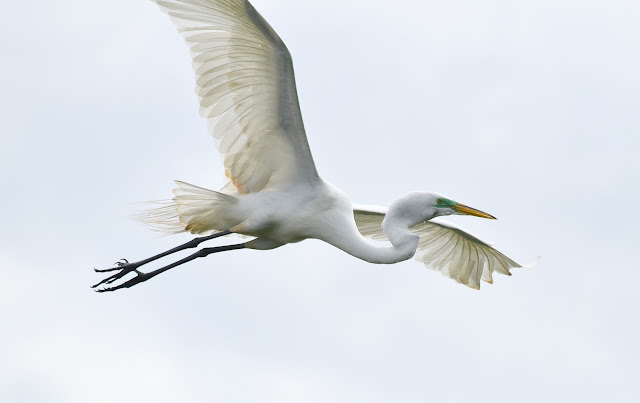The Great White Egret is a majestic bird! Its size and pristine white color add to its grace and charm, and to watch one take flight is an exhilarating experience.
They are usually solitary birds, but come breeding season, some very interesting changes begin. There are rituals. First, they need to find a mate, and shed their solitary habit for a few weeks. This takes some adjustment. One of the most showy aspects of the process is that the birds develop breeding plumage, long feathery plumes called aigrettes. You can see how one struts the feathers to impress! There is also the development of a beautiful neon green patch near the eyes and bill, called lores.

There is an elaborate dance like sequence they engage in to get noticed.

The beak goes up in the air and the aigrettes form a fan like pattern.
And more of the same!
Then there is a swoop, the neck goes all the way down.
And back again to some showing off!
Pardon me if I have gone overboard with these pictures, but it is so fascinating to watch!
A chinaberry tree in bloom provides a perfect backdrop for this eye catching performance.
There are other birds around performing similar actions, or some already nesting or rearing young chicks.

Once the pair has chosen one another, there is some bill clapping. This helps in them getting to know one another.

There is loud squawking during the 'getting to know each other' process.

Once the pair is formed, they get busy, there is plenty to do.
Nest building is the next step for which stick gathering is a requisite.

Sticks are presented to the mate as gifts.
There are many instances of stick stealing from other nests too. This leads to contentious arguments and fights between members of the same species and of different species (both intraspecific and interspecific). I got a couple of pictures but the fight was happening behind some branches, and the images are blurred.

The demand for sticks seems endless.
Nest building then begins. There is a lot of squawking and preening happening throughout the process.
I did not get to observe mating. Finally, one to six eggs are laid. The eggs are smooth and a light shade of greenish blue.
Incubation. Both parents share the task.
In about 23-27 days, the eggs hatch and the little fluffy hatchlings are welcomed into the world.

Several families nest close to one another.
The chicks have little else to do except eat, rest, grow and look around to see a lot of action.

A parent flies in towards the nest.
Landing to find an eager family waiting.
Perfect family portrait!
Back again they go to find food.
The others wait, and the chicks forever hungry. Parents feed the chicks by regurgitation. The nesting period is about 25 days. The young ones stay close to the nest even after leaving it.
This nesting site houses several nests, and different kinds of birds.
There are Cormorants, White Egrets, Roseate Spoonbills, Snowy White Egrets, Tricolored Herons, Little Blue Herons. I will post a few pictures of the others too.
A Cormorant pair incubating eggs.
A Tricolored Heron flies in the hope of finding a mate.
It lands on a tree with a promising prospect nearby.

The dance begins. Note the cobalt blue patch near the beak, a part of breeding plumage for this species, along with long feathers on the back.
The task of stick gathering again!

A Tricolored Heron and Great White Egret looking for sticks. The blue beak on the Heron is beautiful!

A courtship dance of Snowy Egrets. Apologies for the blurry picture.
Stick gathering is part of the process for all species.
They sit by the water, and choose the strongest sticks.
The sticks are almost as long as the body length sometimes.
The nest is then built, and eggs are laid.

Waiting for the eggs to hatch.
It is not an easy life for these creatures. There is competition, for mates, for resources, and then there are predators. See an alligator lurking at the back?
A dead Spoonbill lies in the background. Probably due to a fight, or a predator. It's the cycle of life. New ones are born in nests in the trees above, and forces of nature that monitor balance of numbers are at play at the same time. The animal world still plays by those rules. To a large extent.


























































